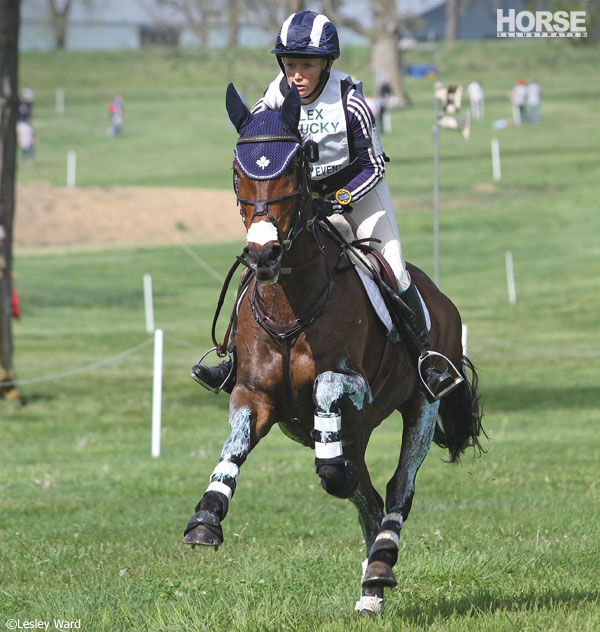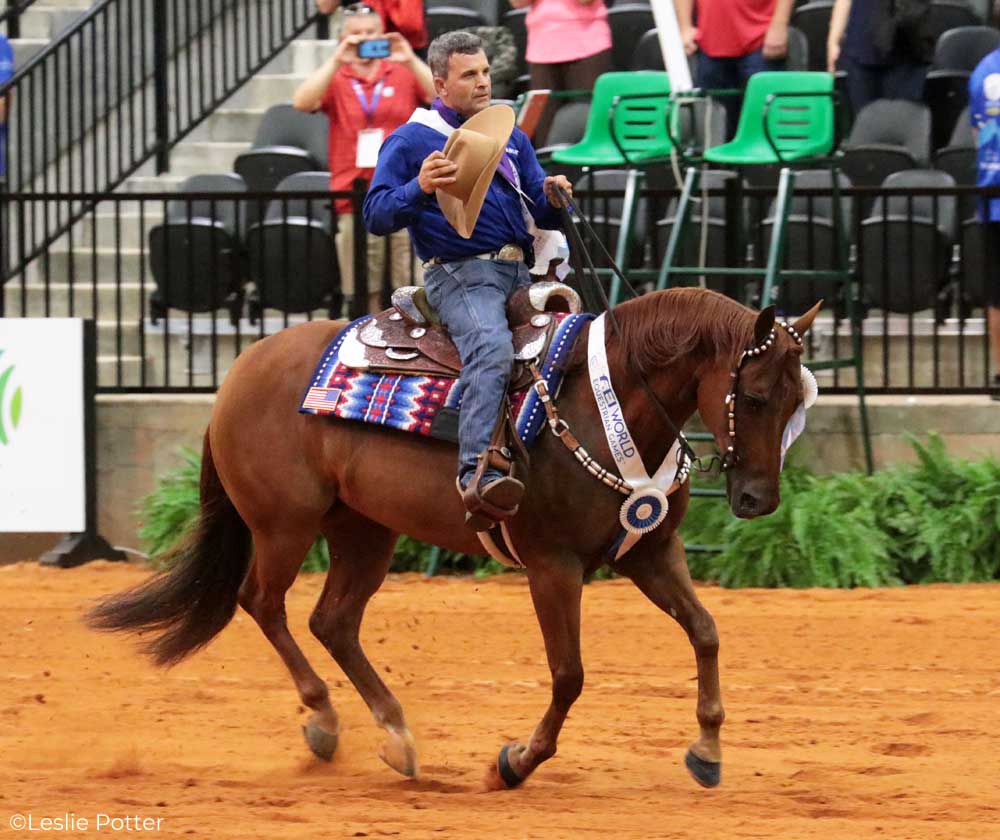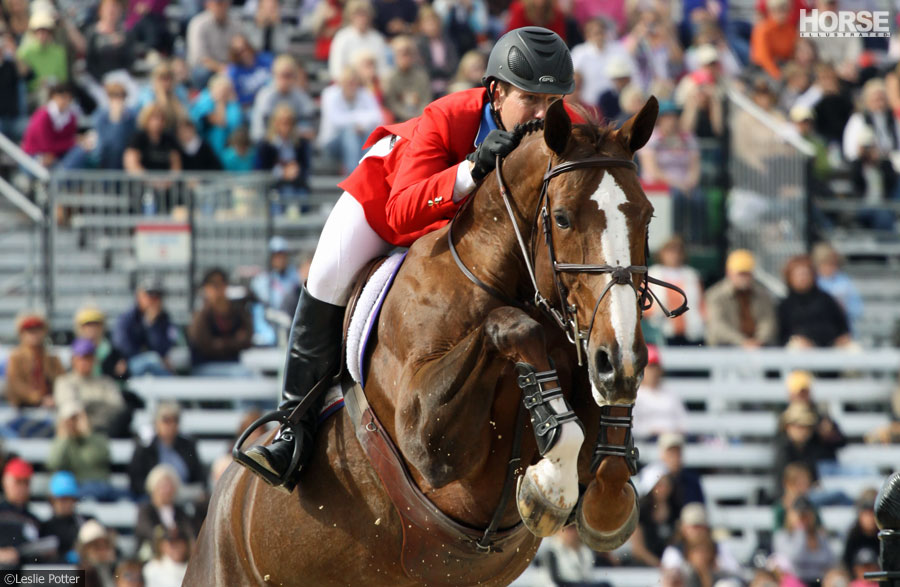Mares are a polarizing group: People seem to either love them or loathe them. Because of this great divide, there are many myths and misconceptions about mares. However, top riders who have cracked the code know what it takes to bring out the best in their female mounts.

We’ll also separate fact from fiction with veterinary insight from equine reproductive specialist Ryan Ferris, DVM, a clinical sciences and equine reproduction faculty member at Colorado State University.
Atop the Leaderboard
Pete and Tamra Kyle breed, train and show reining horses out of Kyle Ranch in Whitesboro, Texas. The Kyles’ American Quarter Horse, A Ruf Gal, was named the 2013 USA Reining Horse of the Year and a United States Equestrian Federation International Horse of Honor, in addition to topping over $100,000 in prize winnings.
Based in Temecula, Calif., at Terry and Linda Paine’s Kingsway Farm, Canadian native Hawley Bennett-Awad has been short-listed for the Canadian three-day eventing team five years in a row with 14-year-old Thoroughbred mare Gin & Juice (“Ginny”). Bennett-Awad’s partnership with Gin & Juice spans a 2010 Alltech FEI World Equestrian Games team silver win, a trip to the 2012 London Olympics, and top finishes at the world’s most prestigious four-star three-day events. Gin & Juice was also named the 2010 United States Eventing Association (USEA) Mare of the Year and was ranked No. 19 on the USEA’s Historical High Score Horses list this February.
The Great Mare Debate
The riders of these two standout mares agree that mares have personality, but it’s not a problem. In fact, they have shown that a good mare could be your ace in the hole.
“When I started riding Ginny, it was all about taking my time with her and being patient,” says Bennett-Awad. That slow approach has paid off in the form of trust, confirming what many riders say: A mare that’s on your side will do anything for you. “My relationship with Gin & Juice is such that when I ride her cross-country, I have to be committed because she is going to go. I’ve always been told that a good mare is better than any gelding, and I would have to agree. There’s not another horse I’d rather go cross-country on.”
With Gin & Juice, Bennett-Awad has not encountered any negative “mareish” behavior. “She’s actually really, really sweet,” she says. “Whenever I say her name, she always nickers and comes trotting over. She’s never been mean or ornery. She’s a real tryer. She loves to have a job. I love mares. I think they try a little bit more.”
Ignoring mare stereotypes has paid off for Bennett-Awad. “If I believed the myths, I wouldn’t have Gin & Juice,” she says. “She’s honestly one of the best eventing mares in the world, I think. She’s a little pocket rocket. She has so much presence, so much game, so much will to do whatever I want her to do.”

A Ruf Gal also has a clear sense of herself. “She’s got a lot of attitude as far as personality,” notes Tamra Kyle. “She likes things done her way; she has an element of grit.” While this mare is no pushover, Tamra feels it’s not associated with her cycle or hormones, but is rather simply who she is.
Both Tamra and Bennett-Awad agree that mares often do require a different approach from their male counterparts, as they can be sensitive, and should be ridden with an element of finesse.
Slow and Steady
Not every rider may be ready to agree with these high opinions of mares, however. Mares often have to work that much harder to get noticed.
“In the reining industry, it tends to be hard to find good mares that compete,” explains Tamra. “They tend to be slower to market; the colts at the yearling sales sell pretty quickly, while the fillies always seem to have to prove themselves first.”

For the Kyle family, that long haul has paid off: Pete is not the only family member to garner notable winnings with A Ruf Gal. Tamra finished at the top of the American Quarter Horse Association (AQHA) adult amateur standings with her, while their son, Reed, nabbed team and individual gold at the Fédération Equestre Internationale (FEI) North American Junior & Young Rider Championships. To attain such diverse wins, consistency is key.
“You need consistency and a steady program with a mare,” says Tamra. “You’re not going to be able to cram with a mare. I do think you approach them a little differently in the training process. There are good days and bad days; you can’t take it personally.”
Working Moms
While breeding is not on the agenda for the majority of mare owners, big-time mares are sometimes called on to be working moms. Both Gin & Juice and A Ruf Gal have been bred by embryo transfer while training and showing. Gin & Juice was bred after competing at the Badminton Horse Trials CCI4* in England and now has a 2-year-old on the ground.
A Ruf Gal took it a step further, competing at a top reining venue during a time when she was being prepped to breed. “She made the finals at the [National Reining Horse Association] Derby, and we bred her that evening, then brought her home five days later and flushed the embryo,” says Tamra. “While in heat, she’s still a really good mare to show.” In her first year of competition with the Kyles, A Ruf Gal was bred for two embryo transfers.
Performing double duty is not that uncommon for top reining mares, explains Tamra, noting that quality mares are often training and competing while also undergoing embryo extraction.
Keeping it Natural
Many owners seek intervention in managing their mares’ cycles, while others prefer a more natural approach. Bennett-Awad once tried Gin & Juice on progestin to regulate her cycles but found that the mare didn’t behave any differently from when she wasn’t on it. From that point on, Bennett-Awad has let Gin & Juice be her normal self.
Perhaps the best mare-management strategy for Gin & Juice has been group turnout with other mares. “Ginny was born at Kingsway Farm in a field with other mares and grew up in a field with probably 12 other mares,” says Bennett-Awad. “To this day, she is turned out every night with two other mares. I think it’s really important that horses get to be horses. When they get to grow up in the field with a dominance factor, they learn respect from other horses.” Even prior to her Olympic debut, Gin & Juice enjoyed pasture time with her buddies.
The Kyles’ show mares are also not on anything to manage their cycles. “That’s not part of our training regimen; for a lot of people it’s automatic,” says Tamra. “It’s a credit to Pete’s training program; we haven’t ever really had trouble with mares. We’ve even shown mares that are actually a little bit better when they’re in heat.”

Tamra recommends owners be aware of when their mare is cycling. If a mare has a day when she is sore or moody, it’s a good idea to adjust her training program. This approach has obviously worked for the Kyles. While winning big with A Ruf Gal, Pete was campaigning another mare, Gunner Git Ya Dun, that also simultaneously earned major winnings. “To have two mares of that quality on the road at the same time makes for a pretty fun year,” says Tamra.
The Doctor is In
Maybe you are lucky enough to have an easygoing mare like Gin & Juice and A Ruf Gal, or maybe your mare could use a little intervention to get through her heat cycle. Mares typically experience a 21-day cycle with five to seven days in season, meaning over a three-week period, she’ll be in heat for about one week, with two weeks out of heat. When a mare enters her heat cycle, estrogen levels rise and remain elevated until ovulation. Once ovulation occurs, progesterone levels rise for about two weeks, then decline again as she completes her cycle. It is the estrus, or heat, period that causes many mare owners headaches.
Typical behavior for many mares in season can include squatting with legs spread and tail raised, urinating, and winking with the vulva. Some mares may be submissive, while others may be more dominant. In addition, some mare owners report greater sensitivity in their mares at this time. From a training standpoint, these conditions may not be ideal.
“Most owners are happy with their mares’ behavior when they are out of heat, exhibiting biddable behavior during diestrus,” explains Ryan Ferris, DVM. Addressing issues that may accompany a mare’s heat is a problem you have to face about two-thirds of the year, as a mare is in anestrus (in reproductive downtime) during the winter months (November to February). Mares have their normal 21-day cycle late spring through early fall (May to October), with transition periods before spring as the ovaries ramp up for reproduction and before fall as the reproductive state slows down. During the transition periods, a mare may seem to be in constant heat as she grows follicles but fails to ovulate.
If your mare experiences difficulties associated with estrus, Ferris outlines several options for managing her cycles. Probably the most commonly used option is administration of a synthetic progesterone (progestin) altrenogest, such as Regu-Mate, which Ferris notes is the most widely recommended method for suppressing estrus behavior. “Regu-Mate is very reliable and works safely on virtually all mares,” says Ferris. It works by keeping mares from going into heat. The two big drawbacks are daily oral administration and the need for people to avoid any skin contact with the medicine due to its hormonal content. Mares return to their regular cycles after discontinuing the hormone.
Infusion of plant oil into the mare’s uterus is a new technique many people may not be familiar with. “Intrauterine infusion with plant oil following ovulation results in maintenance of the mare’s CL [corpus luteum], just like when she is pregnant,” explains Ferris. “This CL secretes progesterone for the next two to three months.”

Injectable oxytocin therapy also mimics a pseudopregnancy. While highly effective, Ferris notes the major drawback for both oxytocin and the plant oil protocol is the variable time frame for estrus suppression, with typical time frames lasting two to three months.
Herbal remedies can be problematic, notes Ferris, as many have not been proven to consistently work. Also, owners of performance mares need to be vigilant about the contents of herbal supplements, as many (if not most) ingredients are banned under competition rules.
Owners that run into cycling issues and are certain they will never want to breed their mare may consider an ovariectomy. “Removal of the ovaries is a minimally invasive laparoscopic surgery,” says Ferris. “Interested owners should evaluate their mare’s behavior during the anestrus cycle during winter; this is similar behavior to when the mare gets an ovariectomy.”
Intrauterine marbles, which suppress estrus by tricking the uterus into thinking the mare is pregnant, tend to work in only about 30 to 40 percent of cases, explains Ferris. In other words, this technique is unfortunately unreliable.
Last but not least, don’t be too quick to blame any and all problems associated with mares on their biology. “When a performance mare shows adverse behavior or isn’t amenable to training, everyone wants to blame it on her estrus cycle,” says Ferris. “I recommend tracking the mare’s cycle and behavior on a calendar to determine if it’s associated with the estrus cycle. If it is, I can work with the client to help minimize the situation.”
Give your girl the benefit of the doubt first. Then, if her behavior is associated with her normal cycle, many treatment options are available.
More on Mares:
Question of the Week: Taming the Aggressive Alpha Mare
All Mare and Foal Resources
Question of the Week: Birth Control for Mares
NATALIE DeFEE MENDIK is an award-winning freelance writer specializing in equine media. Her personal horsey passions include dressage and vaulting. Visit her online at www.mendikmedia.com.
This article originally appeared in the June 2014 issue of Horse Illustrated. Click here to subscribe.






Watching Gin & Juice and Hawley Bennett-Awad I got tears in my eyes and my heart swelled because I understand their relationship. I have one like that with my mare. Its about trust, understanding, partnership and love. There is an understanding with mares like that, I have never had with any other horses. They are the special ones, and when they’re special, WOW. There is nothing like a wonderful mare! It surpasses all else!
My mares are the best mounts ever! We understand one another. I have had problems with geldings, who know why? Horsenality and women riders could make a different relationship, perhaps. LOVE THE MARES!
My mares are the best mounts ever! We understand one another. I have had problems with geldings, who know why? Horsenality and women riders could make a different relationship, perhaps. LOVE THE MARES!
My first horse, purchased 25 years ago, was a little QH mare. The Kyles’ descritions of A Ruf Gal and Gin and Juice described my Cinnamon Twist to a tee. I NEVER had any “mare” problems with her: while she definitely was bossy with other horses, once the saddle was on her back, she was all-business. She was a bombproof babysitter, a confidence builder, a tough competitor, and the best jumper I have ever owned. I miss her so much!
My first horse, purchased 25 years ago, was a little QH mare. The Kyles’ descritions of A Ruf Gal and Gin and Juice described my Cinnamon Twist to a tee. I NEVER had any “mare” problems with her: while she definitely was bossy with other horses, once the saddle was on her back, she was all-business. She was a bombproof babysitter, a confidence builder, a tough competitor, and the best jumper I have ever owned. I miss her so much!
My first horse, purchased 25 years ago, was a little QH mare. The Kyles’ descritions of A Ruf Gal and Gin and Juice described my Cinnamon Twist to a tee. I NEVER had any “mare” problems with her: while she definitely was bossy with other horses, once the saddle was on her back, she was all-business. She was a bombproof babysitter, a confidence builder, a tough competitor, and the best jumper I have ever owned. I miss her so much!
I love my mare. They have more heart than a gelding and safer than a stallion. I have had mares since I have been ridding.